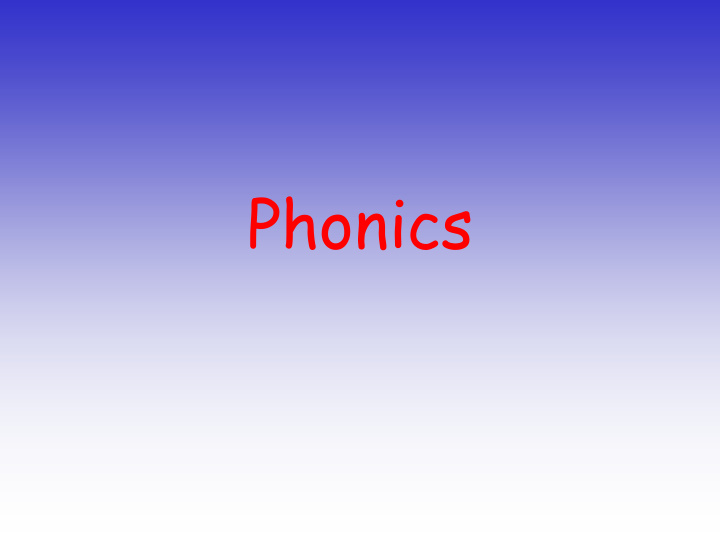



Phonics
Phonics at a glance Phonics is… Skills of Knowledge of segmenting the alphabetic (breaking words into code. sounds) and blending (putting sounds together to make a word)
The Alphabet a b c d e f g h i j k l m n o p q r s t u v w x y z
Some Definitions A Phoneme This is the smallest unit of sound in a word. How many phonemes can you hear in cat ?
A grapheme These are the letters that represent the phoneme. A grapheme can be 1 letter, 2 letters or more! e.g t, ai, igh. We refer to these as sound buttons . tug light laid
• A phoneme you hear • A grapheme you see
Phonics Consists of: • Identifying sounds in spoken words. • Recognising the common spellings of each phoneme. • Blending phonemes into words for reading. • Segmenting words into phonemes for spelling.
Blending (for reading) • Recognising the letter sounds in a written word e.g c-u-p, sh-ee-p. • Merging them in the correct order to pronounce the word ‘cup’ and ‘sheep’.
Segmenting (for spelling) • Identifying the individual sounds in a spoken word (e.g. h-i-m , s-t-or-k) and writing down letters for each sound (phoneme) to form the word ‘him’ and ‘stork’.
The Letters and Sounds Phases explained! Phonic and reading skills are taught in 6 distinct phases. In Reception we make sure the children are secure within Phases 2 and 3. Some children may enter phase 4/5.
Phase 1 Showing an awareness of rhyme (cat/mat) and * alliteration (Harry the hungry horse). * Distinguishing between sounds in the environment and phonemes. * Exploring and experimenting with sounds and words. * Discriminating speech sounds in words. * Beginning to orally blend and segment phonemes.
Phase 2 • Using common consonants and vowels. • Blending for reading and segmenting for spelling simple cvc (consonant/vowel/consonant) words. • Understanding that words are constructed from phonemes and that phonemes are represented by graphemes.
Letter sets are taught in patterns of about four per week (phase 2) Set 1 - s, a, t, p Set 2 - i, n, m, d Set 3 - g, o, c, k Set 4 - ck, e, u, r Set 5 - h, b, f, ff, l, ll, ss These ‘alphabet’ sounds can be taught with Jolly phonic actions
Phase 3: Knowing and applying one grapheme for each of the 42 phonemes. There are 42 phonemes in the English language! Enunciation • Teaching phonics requires a technical skill in enunciation. • Each phoneme (sound) should be articulated clearly and precisely.
s a t p i n m d g o c (k) e u r h b f l j v w x y z qu Consonant ch sh th ng digraphs oo /oo ai ee igh oa ar or ow oi ear air ure er/ur
Grapheme Key Vocabulary 2 letters making one • Digraph sound ( ch, sh, ai, ee) 3 letters making one • Trigraph sound (igh, ear) Where the two letters • Split digraph are not adjacent (Phase 5) (a-e, e-e)
Key words and Tricky words Alongside ‘phased’ phonic teaching, children also learn high frequency and ‘tricky’ words (those that are not spelt phonetically) e.g ‘go’. There are 300 high frequency words to learn! (100 in Rec/Y1 and an additional 200 in Year 2)
FINALLY! Children should always work within the phase that is appropriate to their level of learning. It’s called ‘Foundation Stage’ for a reason... without strong foundations a house will fall down!
Recommend
More recommend